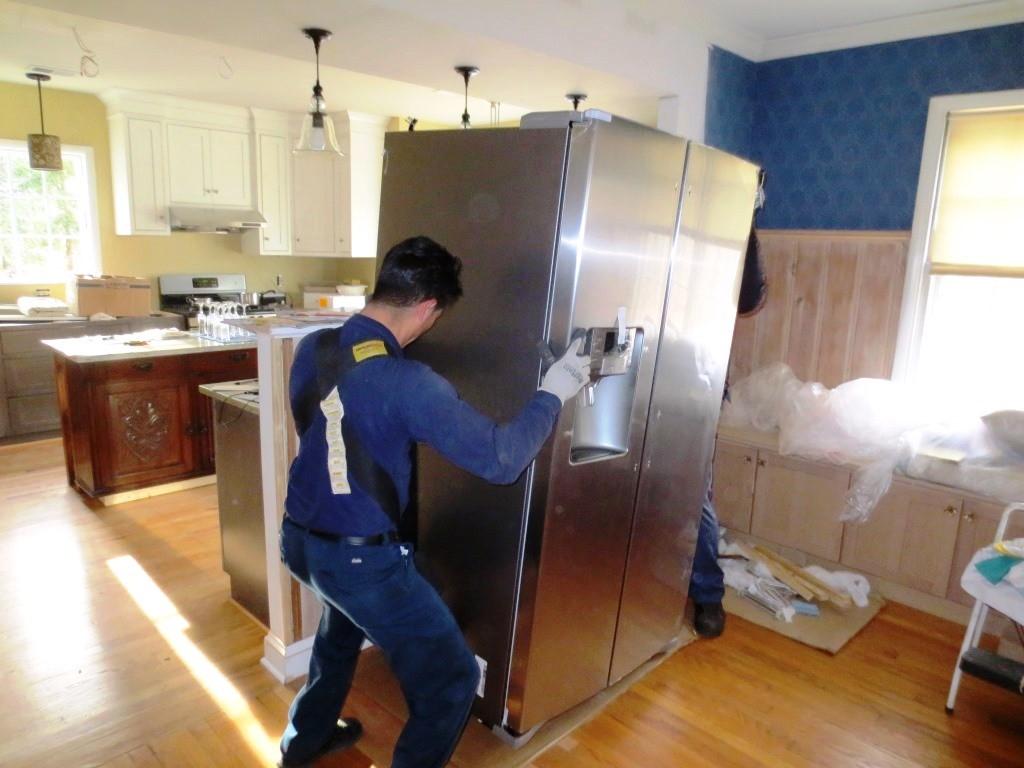Moving a refrigerator can feel like a monumental task. It’s bulky, heavy, and precious – the last thing you want is to leave a trail of scuffs and scratches on your beautiful floors in its wake. But fear not, moving a refrigerator without causing damage is achievable with the right approach and a little bit of planning.

Image: spasifikmag.com
This guide will equip you with the knowledge and strategies to move your refrigerator safely and efficiently, leaving your floors unscathed. We’ll cover everything from choosing the right tools and techniques to understanding the importance of protecting both your appliance and your surfaces.
Preparing for the Move
1. Clear the Path
Before you even think about lifting a finger, ensure a clear, unobstructed path from the starting point to the destination. Remove any obstacles – furniture, rugs, boxes, pets, and even curious children! A clear path prevents unnecessary bumps, scrapes, and potential accidents.
2. The Right Tools
A few essential tools will make your move smoother and safer:
- Moving dollies or furniture sliders: These provide smooth, even support for your refrigerator, reducing friction and strain on your back. Choose dollies with a platform large enough for your appliance’s base.
- Furniture pads or moving blankets: These soft, protective layers cushion the refrigerator and your floor during the move. You’ll want to cover both the top and sides of the refrigerator for complete protection.
- Tape measure: Take accurate measurements of doorways, hallways, and the space where you intend to place the refrigerator to ensure it will fit comfortably.
- Gloves: Protect your hands from rough surfaces and potential cuts.

Image: www.youtube.com
3. Clear the Refrigerator
Before moving your refrigerator, remove all items from inside. Food, shelves, drawers, and even accessories could shift during the move, potentially causing damage or injury. Make sure to empty water and ice from the dispenser.
Moving the Refrigerator
1. Protect your Floors
Start by laying down a protective layer over your floors. This could be moving blankets, furniture pads, or even sturdy cardboard. Choose a material that won’t slip or crumble under the weight of the refrigerator.
2. Lift and Slide
Place furniture sliders or a moving dolly under the refrigerator. Use caution when lifting, as refrigerators are incredibly heavy. If you’re working with a dolly, remember to secure the refrigerator with straps to prevent it from falling off.
3. Maneuver with Care
Push the refrigerator using gentle, even pressure, always moving in a straight line to avoid any unwanted twisting or bumping. If your refrigerator has wheels, you can use them, but be cautious on uneven surfaces.
4. Position and Secure
Once the refrigerator is in its new position, remove the sliders or dolly. Double-check that it’s level and that all doors and drawers are functional.
Tips for Extra Protection
1. The Power of Padding
Don’t underestimate the power of padding. Place extra moving blankets or furniture pads between the refrigerator and the wall to prevent direct contact and minimize potential scratches. This is especially important if your walls are particularly delicate.
2. Avoid Sharp Turns
Sharp turns can create unnecessary friction and could result in scratches. When navigating corners, try to maneuver the refrigerator with a gentle, wide arc instead of making abrupt turns.
3. The Power of Two
Moving a refrigerator is a two-person job. Having a helper ensures the refrigerator is lifted and moved safely and effectively, reducing the risk of accidents and scratches.
Additional Considerations
1. The Floor Type
Consider the type of flooring you have. Hardwood floors, tiles, and laminate are particularly susceptible to scratches. Extra caution and protective measures are essential. Carpet offers some inherent protection, but it’s still important to use furniture sliders and moving blankets.
2. The Weight of the Refrigerator
Don’t underestimate the weight of a refrigerator. Ensure you have the necessary physical strength for the task or enlist help from strong friends or professionals.
3. The Value of Professional Help
If you’re uncomfortable moving the refrigerator yourself, consider hiring professionals. Moving companies are equipped with the tools, expertise, and insurance to move bulky appliances safely and efficiently.
How To Move Refrigerator Without Scratching Floor
Conclusion
Moving your refrigerator doesn’t have to be a stressful experience. By taking the necessary precautions, using the right tools, and planning your move strategically, you can successfully move your refrigerator without leaving a mark on your floors. Remember, safety first, and always prioritize both your own well-being and the protection of your precious appliance.
For more tips and resources on moving a refrigerator, consult with a professional mover or visit online moving guides. With a little planning and preparation, you can conquer this common household task with confidence!





